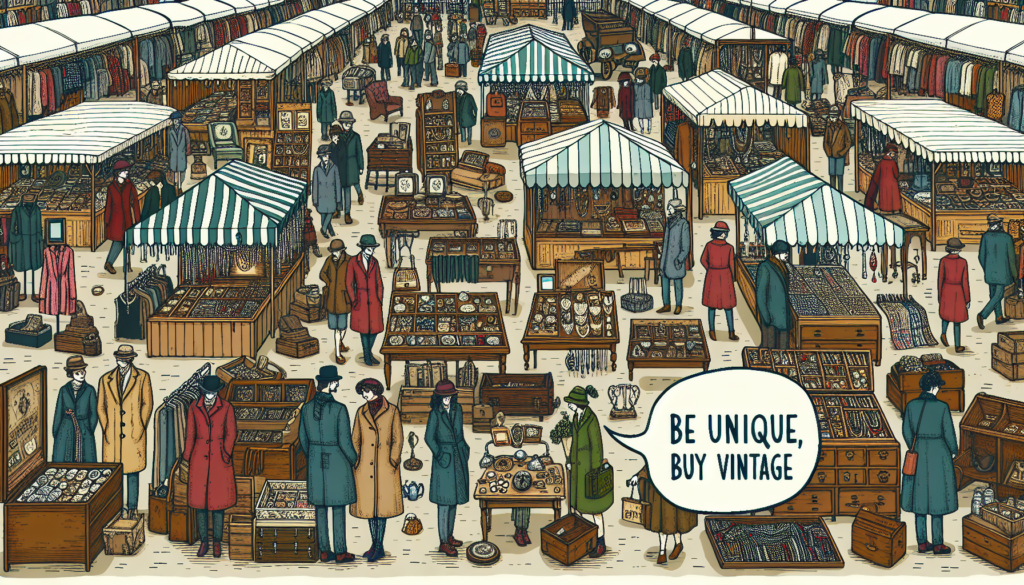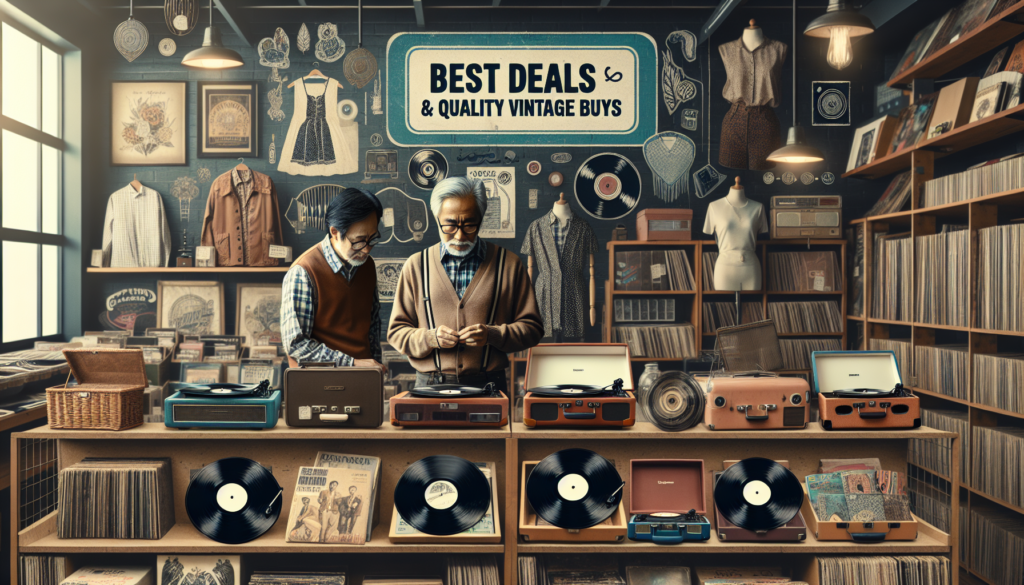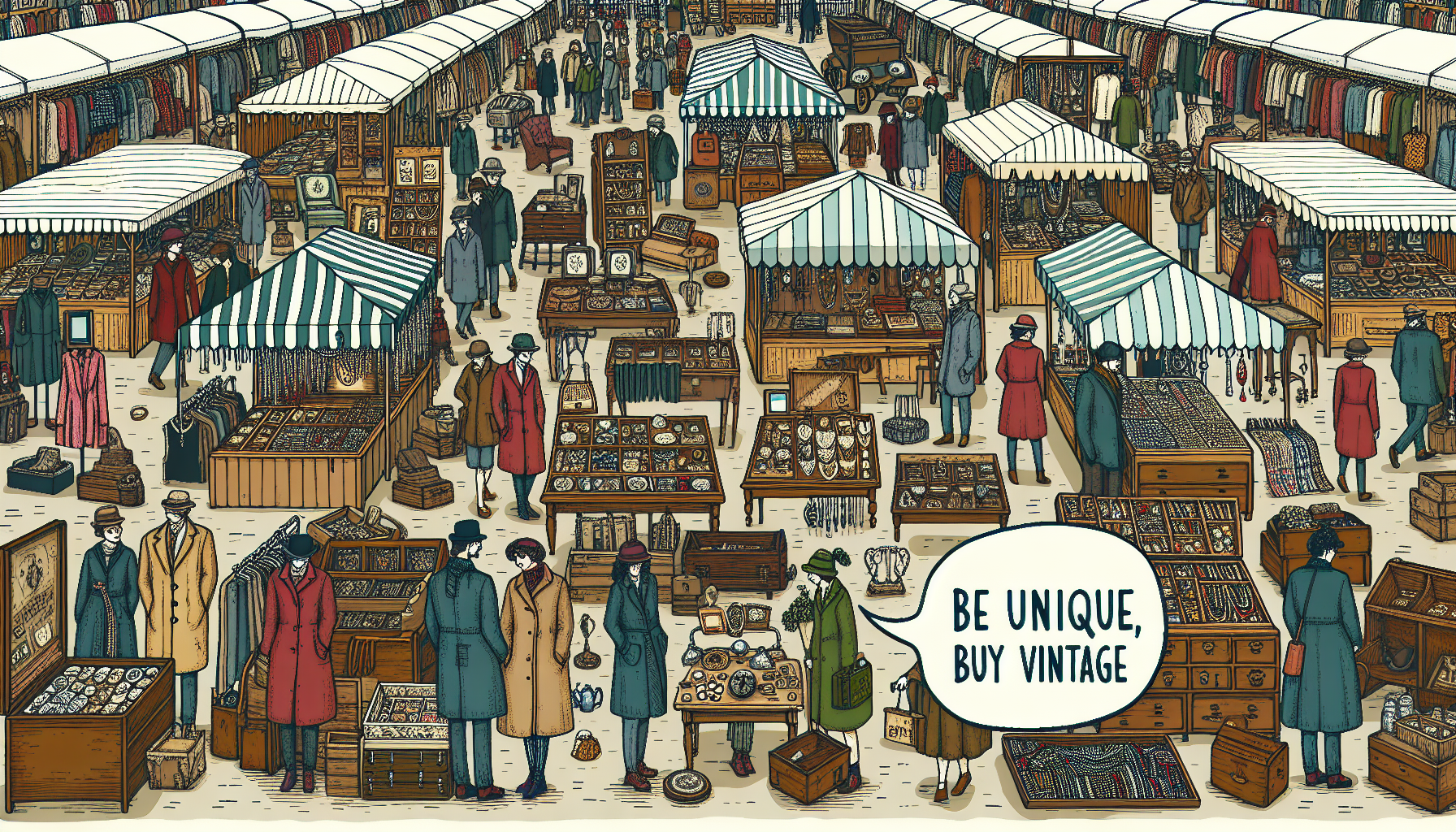Are you interested in finding unique and affordable fashion pieces? Look no further than the world of second-hand and vintage shopping! In this guide, you’ll discover a wealth of tips and tricks to help you navigate the world of pre-loved fashion. From where to find the best second-hand stores to how to assess the quality of vintage items, this article has got you covered. With a little guidance, you’ll be able to curate a stylish wardrobe while embracing sustainability and saving money along the way. So, let’s embark on this exciting journey together!

Researching Second-Hand and Vintage Items
Understanding the Benefits of Buying Second-Hand and Vintage
When it comes to shopping for clothing, furniture, or other items, buying second-hand or vintage can offer numerous benefits. First and foremost, it is a more sustainable and eco-friendly option, as it reduces the demand for newly manufactured goods and minimizes waste. Additionally, buying second-hand items often allows you to find unique and one-of-a-kind pieces that are not available in mainstream stores. This can help you express your personal style and create a more individualized look. Moreover, purchasing second-hand or vintage items can be a budget-friendly alternative, as they are generally more affordable than buying brand new. With all these advantages, it is clear why more and more people are turning to second-hand and vintage shopping.
Identifying the Difference Between Second-Hand and Vintage
While the terms second-hand and vintage are often used interchangeably, there is a distinction between the two. Second-hand items are simply pre-owned or used goods that have been previously worn or used by someone else. These items can range from clothing and accessories to furniture and electronics. On the other hand, vintage refers to items that are at least 20 years old and often have a classic or retro aesthetic. Vintage items are typically known for their quality craftsmanship, unique designs, and historical significance. Understanding this difference is essential when searching for specific types of items or seeking a particular style.
Exploring Different Types of Second-Hand and Vintage Items
When it comes to second-hand and vintage shopping, the options are truly endless. Clothing and accessories are among the most popular categories, with a wide range of styles and eras to choose from. From timeless vintage dresses to retro graphic tees, you can find pieces that suit your personal style and preferences. Additionally, furniture and home decor items are often available in second-hand and vintage stores, allowing you to give your living space a unique and eclectic touch. Other categories worth exploring include books, vinyl records, collectibles, and even vintage electronics. So whether you are searching for a fashionable outfit or a statement piece for your home, the world of second-hand and vintage has something for everyone.
Determining Your Style and Preferences
Before diving into the world of second-hand and vintage shopping, it is important to have a clear understanding of your personal style and preferences. Vintage clothing and accessories span various eras, each with its own distinct aesthetic. Are you drawn to the elegance of the 1950s or the rebellious spirit of the 1980s? Exploring different eras can help you determine what resonates with your style and allows you to curate a unique wardrobe that reflects your personality. Similarly, when it comes to furniture and home decor, consider the overall theme or vibe you want to achieve in your space. Whether it’s mid-century modern, bohemian, or industrial, having a clear vision will make your second-hand and vintage shopping experience more focused and enjoyable.
Where to Find Second-Hand and Vintage Items
Local Thrift Stores and Consignment Shops
One of the most accessible and popular places to find second-hand and vintage treasures is your local thrift store or consignment shop. These establishments often offer a wide variety of items, ranging from clothing and accessories to furniture and housewares. Thrift stores are particularly known for offering affordable prices, making them an excellent option for budget-conscious shoppers. Consignment shops, on the other hand, may carry higher-end or designer items and often focus on curating a more curated and selective collection. Exploring these local establishments not only supports your community but also gives you the chance to discover hidden gems.
Online Marketplaces and Auction Websites
In the digital age, online marketplaces and auction websites have become a go-to resource for second-hand and vintage shopping. Platforms like eBay, Depop, and Etsy offer a vast array of items, allowing you to browse through different categories, eras, and styles from the comfort of your own home. These online platforms also provide the opportunity to connect with sellers from all over the world, expanding your options and increasing the likelihood of finding that perfect vintage piece. However, it is important to exercise caution and thoroughly research the seller’s reputation and return policies before making a purchase.
Garage Sales and Estate Sales
For those who enjoy the thrill of treasure hunting, visiting garage sales and estate sales can be an exciting way to find second-hand and vintage items. These sales often offer a wide range of goods, from clothing and antiques to furniture and collectibles. Garage sales are typically held by individuals looking to declutter and sell unwanted items, while estate sales occur when someone’s personal belongings are sold off, often due to a move, downsizing, or as part of an estate settlement. Attending these sales in your local area can lead to unexpected finds and hidden gems at affordable prices.
Flea Markets and Yard Sales
Flea markets and yard sales provide another avenue for discovering second-hand and vintage treasures. Flea markets are typically community-based events where vendors come together to sell various goods, including antiques, collectibles, clothing, and furniture. These markets often have a vibrant and bustling atmosphere, making them an enjoyable experience for shoppers. Yard sales, on the other hand, are typically held by individuals at their own homes and offer an opportunity to browse through a more personal selection of items. Both flea markets and yard sales can be a great way to find unique pieces and strike up conversations with fellow vintage enthusiasts.
Antique Stores and Vintage Boutiques
For those seeking more curated and specialized collections, antique stores and vintage boutiques are the prime destinations. Antique stores specialize in selling items that are at least 100 years old, such as furniture, decor, jewelry, and art. These stores often offer a higher level of expertise and knowledge regarding the historical significance and value of the items they carry. Vintage boutiques, on the other hand, focus on curated collections of clothing, accessories, and home decor from specific eras or styles. These boutiques often offer a more refined and selective shopping experience, ensuring that every piece meets their style and quality standards.
Evaluating the Condition and Quality
Inspecting the Item for Damages and Wear
When buying second-hand or vintage items, it is crucial to thoroughly inspect them for any damages or signs of wear. Check for stains, tears, missing buttons, or broken zippers in clothing. Examine furniture for scratches, dents, or loose joints. It is also important to be aware that some vintage items may show natural signs of aging or slight wear, which can add character and authenticity. However, make sure that any wear or damage is within your acceptable level and won’t compromise the usability or structural integrity of the item.
Checking for Authenticity and Originality
Authenticity and originality are key factors when buying second-hand or vintage items, especially those with high value or collectible status. When it comes to clothing and accessories, look for original labels, tags, or brand markings that indicate the item’s authenticity. For furniture and home decor items, check for manufacturer’s marks, stamps, or signatures that authenticate their origin and craftsmanship. If you have doubts about the authenticity of an item, consider seeking expert opinions or doing further research to verify its legitimacy.
Assessing the Quality and Durability
One of the advantages of buying second-hand and vintage items is the potential for finding high-quality and durable goods. Vintage items were often made with superior craftsmanship and materials, which can contribute to their longevity. When evaluating the quality of an item, pay attention to the overall construction, stitching, and material condition. Assess whether the item looks and feels sturdy, and if it has stood the test of time. Quality and durability are essential to ensure that your purchase will last and continue to bring you joy for years to come.
Researching the Brand or Designer
If you come across a second-hand or vintage item from a well-known brand or designer, it is worth taking the time to research its background and history. Understanding the reputation and significance of certain brands or designers can provide valuable insights into the quality, value, and desirability of the item. Knowing more about the brand’s heritage and style can also help you make a more informed decision and appreciate the item’s unique qualities.
Considering Pricing and Value
Comparing Prices with New Items
When determining the value of second-hand and vintage items, it is helpful to consider their pricing compared to their brand new counterparts. Research the original retail prices of similar items and compare them to the prices you see in the second-hand market. This will give you an idea of the potential savings you can get by buying second-hand, as well as the value of the item in its current condition. It is important to note that rare or highly sought-after vintage items may command higher prices due to their scarcity or desirability.
Taking into Account the Rarity or Desirability
The rarity or desirability of an item is a crucial factor in determining its value. Certain vintage pieces or collectibles may be highly sought after by enthusiasts or collectors, driving up their prices. Items that are harder to find or are in high demand can be considered more valuable. On the other hand, common or readily available second-hand items may have lower price points. Consider the rarity or desirability of the item you are interested in to ensure you are making an informed decision.
Factoring in the Age and Historical Significance
The age and historical significance of an item can also affect its value. Older vintage items from specific eras may be considered more valuable due to their historical relevance or cultural impact. For example, furniture from the mid-century modern period or clothing from significant fashion movements like the ’60s mod era might have higher value and be sought after by collectors and enthusiasts. Understanding the historical context and significance of an item can provide insights into its value and help you determine whether it aligns with your preferences and interests.
Considering the Condition and Maintenance Costs
While the initial price of a second-hand or vintage item may be lower than its new equivalent, it is important to consider the potential maintenance costs. Older items may require more care and upkeep to ensure their longevity. For example, antique furniture might need regular refinishing or reupholstering, and delicate vintage clothing may require special cleaning methods. Factor in these additional costs when evaluating the overall value of the item and decide whether it aligns with your budget and willingness to invest time and resources in its maintenance.

Sizing and Fit Considerations
Understanding Sizing Standards and Measurements
One of the challenges when buying second-hand or vintage clothing is navigating the different sizing standards and measurements used in different eras. Sizing standards have evolved over time, and what was considered a size 8 decades ago may no longer be the same as today’s size 8. It is important to familiarize yourself with vintage sizing charts and measurements to ensure a more accurate fit. Consult online resources or vintage clothing experts to understand how sizing has changed over the years and how it corresponds to modern sizing.
Getting an Accurate Measurement
To ensure a proper fit when buying second-hand or vintage clothing, it is crucial to obtain accurate measurements of your body. Take your bust, waist, and hip measurements and compare them to the garment’s measurements provided by the seller. Keep in mind that vintage items may have been altered or customized over time, so the measurements might not perfectly match the original size. Communicate with the seller or ask for additional measurements if needed to make sure the item will fit you correctly.
Knowing What Alterations Are Possible
When buying second-hand or vintage clothing, it is essential to be aware of the alterations that can be made to modify the fit. Some alterations, like hemming a dress or taking in the waist of a pair of pants, are relatively simple and can be done by a local tailor or seamstress. However, more significant alterations, such as resizing the shoulders or altering intricate designs, can be more challenging or may compromise the garment’s integrity. Determine what alterations are feasible and whether the additional cost of alterations fits within your budget.
Accounting for Vintage Sizing Differences
When buying vintage clothing, it is important to remember that the sizing may not match the modern standards you are accustomed to. Vintage items often have a slimmer or more tailored fit than contemporary clothing. Additionally, various factors, such as the fabric’s stretch or shrinkage over time, can affect the fit. Be prepared to try on different sizes and styles to find the one that best suits your body type and personal preferences. Don’t be discouraged if the item doesn’t fit perfectly at first, as alterations or styling adjustments can help achieve the desired look.
Eco-Friendly and Sustainable Shopping
Reducing Environmental Impact through Second-Hand Purchases
One of the significant advantages of buying second-hand items is the reduction in environmental impact compared to buying new. Second-hand shopping reduces the demand for new products, which in turn reduces the need for resources and energy consumption associated with manufacturing and transportation. By purchasing goods that already exist, you are contributing to a more sustainable and circular economy. Every second-hand purchase made helps reduce waste and contributes to a greener and more environmentally friendly future.
Supporting the Circular Economy
The circular economy is a concept that promotes reducing, reusing, and recycling resources, ensuring that materials and products are reused and repurposed as much as possible. Buying second-hand items directly supports this circular economy model by extending the lifespan of products and preventing them from ending up in landfills. When you purchase second-hand or vintage items, you are participating in a more sustainable and environmentally friendly way of consuming, helping to reduce the environmental burden caused by the fashion and manufacturing industries.
Avoiding Fast Fashion and Overconsumption
Fast fashion, characterized by the quick turnover of trends and inexpensive, low-quality clothing, has significant environmental and social impacts. By opting for second-hand or vintage shopping, you can consciously avoid supporting this harmful practice. Second-hand items allow you to create a unique and personal style that reflects your individuality, rather than conforming to mass-produced trends. By shifting away from overconsumption and choosing quality over quantity, you can contribute to a more sustainable and ethical fashion industry.
Negotiating and Bargaining
Researching the Item’s Market Value
When it comes to negotiating or bargaining for second-hand or vintage items, it is essential to do your research and understand the item’s market value. Compare prices of similar items in similar condition to get a sense of what is a fair price range. Consider factors such as brand, rarity, condition, and desirability when assessing the item’s value. By being knowledgeable about the market value, you can approach negotiations with confidence and make an informed offer.
Polite and Respectful Negotiation Techniques
When negotiating or bargaining for a second-hand or vintage item, it is crucial to maintain a polite and respectful demeanor. Approach the seller with kindness and avoid making disrespectful or derogatory comments about the item. Offer a reasonable price based on your research, and be open to a discussion and potential compromises. Building a positive rapport with the seller may increase your chances of reaching a mutually beneficial agreement.
Being Prepared to Walk Away
Negotiating for second-hand or vintage items can sometimes lead to a stalemate or disagreement on the price. In such cases, it is important to be prepared to walk away if an agreement cannot be reached. Remember that the seller has the right to set their price, and you have the right to choose whether it aligns with your budget and perceived value of the item. Being able to walk away from a negotiation shows that you have a clear understanding of your limits and priorities.
Knowing When Not to Negotiate
While negotiation is a common practice in second-hand and vintage transactions, there are situations where it may not be appropriate or feasible to negotiate. For example, in a consignment shop or online marketplace, the seller may have set prices that are non-negotiable. Additionally, if the item is highly sought after or in high demand, the seller may have little incentive to negotiate. Respect the seller’s boundaries and terms, and consider whether the item’s value justifies the price set by the seller.
Tips for Cleaning and Maintenance
Understanding Proper Cleaning Techniques for Different Materials
When it comes to caring for second-hand or vintage items, understanding the proper cleaning techniques for different materials is essential. Different fabrics, metals, and materials require specific care to maintain their condition and prevent damage. Familiarize yourself with appropriate cleaning methods for different items, such as hand-washing delicate clothing, polishing metals, or using special products for vintage furniture. Refer to online resources, consult experts, or seek advice from professional cleaners to ensure you are preserving your second-hand and vintage finds properly.
Dealing with Stains and Odors
One common issue with second-hand and vintage items is the presence of stains and odors. Before purchasing an item, inspect it closely for stains or unpleasant smells. Depending on the material and severity of the stains or odors, there are various ways to address them. For clothing, research stain removal techniques or consider taking it to a professional cleaner. For furniture or home decor, employing deodorization methods or airing out the item in sunlight may help eliminate odors. Assess the extent of the stain or odor and determine whether it can be resolved within your comfort level before making the purchase.
Storing and Preserving Second-Hand and Vintage Items
Proper storage and preservation are crucial to maintain the condition and longevity of your second-hand and vintage items. Store clothing in a cool, dry place away from direct sunlight, and consider using acid-free tissue paper or garment bags to protect delicate fabrics. For furniture and home decor items, avoid exposing them to extreme temperatures or humidity and protect surfaces from scratches or abrasions. Regularly inspect and clean your second-hand and vintage pieces, even during periods of storage, to prevent any deterioration or unnecessary damage.
Avoiding Counterfeits and Reproductions
Researching and Spotting Counterfeit Items
Counterfeit items can be a significant concern in the world of second-hand and vintage shopping, particularly for high-end or luxury brands. Researching the characteristics and details of authentic items can help you spot potential counterfeits. Look for inconsistencies in branding, such as misspellings or inaccuracies in logos or labels. Compare the item to official product images or authentic examples to ensure its authenticity. If you have doubts about the item’s genuineness, seek expert opinions or consult online forums and communities dedicated to spotting counterfeit items.
Examining Labels, Logos, and Engravings
When evaluating the authenticity of a second-hand or vintage item, pay close attention to labels, logos, and engravings. Authentic items often have precise, clean, and high-quality branding. Look for well-executed stitching, crisp logo embroidery, or clear engravings on hardware. Inferior quality or sloppy craftsmanship can be indicators of a counterfeit or reproduction. Familiarize yourself with the genuine branding of the item you are interested in to identify any deviations or inconsistencies.
Seeking Expert Opinions
If you are uncertain about the authenticity of a second-hand or vintage item, do not hesitate to seek expert opinions. There are professionals, such as authenticators or appraisers, who specialize in verifying the authenticity and value of luxury or vintage goods. Reach out to them for their expertise and insights. Additionally, online communities or forums dedicated to second-hand and vintage shopping can often provide valuable advice and guidance based on members’ experiences and knowledge.
Verifying the Seller or Source
When making a second-hand or vintage purchase, it is wise to verify the credibility and trustworthiness of the seller or source. Research their reputation, reviews, and feedback from previous customers to ensure a reliable transaction. Check for clear and detailed item descriptions, including photographs that accurately represent the condition and authenticity of the item. If you have any doubts or concerns about the seller, do not hesitate to reach out to them with questions or request additional information that can help you make an informed decision.
Finalizing the Purchase
Understanding Return and Exchange Policies
Before finalizing a second-hand or vintage purchase, be sure to understand the seller’s return and exchange policies. Each seller or platform may have different policies regarding returns, refunds, or exchanges. Some sellers may offer a grace period for returns or provide clear guidelines for accepting returns in case the item does not meet your expectations. Familiarize yourself with these policies to ensure that you have recourse if the item is significantly different from its description or if unforeseen issues arise.
Inspecting the Item Once Again Before Buying
Just before completing the purchase, take a moment to thoroughly inspect the second-hand or vintage item once again. Verify that it matches the description provided, paying attention to any wear, damages, or inaccuracies. Ensure that you are satisfied with the condition, size, or any other attributes that are important to you. If you are purchasing in person, ask any final questions or request additional photos if necessary. By conducting a final inspection, you can minimize the risk of unexpected surprises or disappointments after the purchase is made.
Securing Safe and Trusted Payment Methods
When making a second-hand or vintage purchase, it is important to use safe and trusted payment methods to protect yourself as a buyer. Ideally, opt for payment methods that offer buyer protection, such as PayPal or credit cards, which offer dispute resolution processes and the ability to get your money back if the transaction does not go as planned. Be cautious when using cash, wire transfers, or unconventional payment methods that offer little recourse in case of fraudulent or problematic situations.
Keeping Records and Receipts for Warranty Purposes
Even when buying second-hand or vintage items, it is helpful to keep records and receipts for warranty or authenticity purposes. If the item comes with any form of warranty or guarantee, ensure that you have the necessary documentation to support any potential claims in the future. Additionally, keeping receipts or invoices can serve as proof of purchase or authenticity should you decide to resell the item later on. Organize these records in a safe place to ensure easy access if needed.
In conclusion, shopping for second-hand and vintage items offers a range of benefits, from sustainability and affordability to the opportunity to express your unique style. By understanding the different types of second-hand and vintage items, exploring various sources, evaluating condition and value, and considering factors like sizing, sustainability, and authenticity, you can confidently navigate the world of second-hand and vintage shopping. With proper research, careful consideration, and a keen eye, you can unearth hidden treasures and build a collection of timeless and cherished pieces. Happy hunting!

